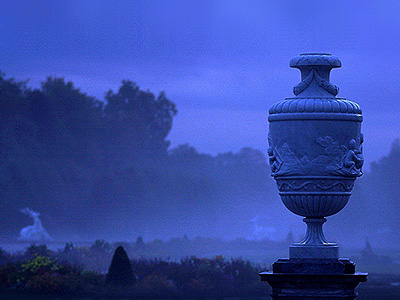
By ANDREW POWELL
Published: June 21, 2014
SCHWETZINGEN — The right setting makes all the difference. At the palace here, a probing six-week spring music festival mirrors the scale and serenity of its context, courtesy each year of Stuttgart broadcaster SWR. Two days last month afforded a sampling of the extended activities: the melodic Arcadian opera Leucippo (1747), nudging forward the slow Hasse revival, and Strauss songs and Brahms trios, which as performed proved equally enlightening.
Schloss Schwetzingen is quite the venue. Its 14th-century embellished castle keep sits on an axis west six miles from bookish Heidelberg. Both towns are now part of metro Mannheim. The axis continues under the building’s arch onto a terrasse flanked by curved Rococo salon wings, festival HQ. Here a perfect large circle of formal greenery permits unique ¾-km intermission strolls, a particle collider for the listener. The line then drops to a vast lower plane of tended tree and bush plantings that hide a Baroque bathhouse, a fake mosque, a shrine to a lyre-playing Apollo and a trellised vision of the Edge of the World. In the contemplative distance, open fields reach the Rhine and the lucrative hilly Pfalz vineyards.
SWR commandeers the palace at an ideal time (April 25 thru June 7 this year). Spring tourism is discreet and decorous, the skies sunny by German norms, the gardens colorful. And May is spargel season: Prince-Elector Karl Theodor — when he wasn’t sponsoring orchestral innovation or Mannheim’s sigh, crescendo, rocket and roller — made Schwetzingen the nation’s spargel capital, and so the beloved but bland big white asparagus, plucked from mounds of earth once the tips show, is on every menu, typically offered under a thick hollandaise.
Festival programs are curated to source SWR broadcasts, balancing input from the company’s three carefully named* orchestras. The fare is chamber music and recitals, mainly, with limited opera and steady veins of new and rare. Ticket sales, something of an afterthought, are constrained by the modest sizes of the theater and two bright salons in those Rococo wings. Built in ten weeks in 1752 and nearly as ornate as Munich’s Cuvilliés Theater, the celebrated opera house holds just 450 people.
Christian Tetzlaff, in the Mozartsaal on May 24, operated as dynamic artistic hinge in Brahms’s three piano trios. He blended flawlessly on one side with the reserved, graceful cellist Tanja Tetzlaff. On the other, he seemed locked in quasi-combat with the grimacing, dramatic, not so lyrical but emphatically focused pianist Lars Vogt. The C-Minor work registered these qualities immediately in a heated, hypnotic reading. The adventurous C-Major followed, duly poignant in its Andante con moto. Given in revised form (1890), the Trio in B Major received equal treatment but managed to sound unrelated, a boisterous world unto itself.
Next door in the Jagdsaal the next morning (May 25), Anna Lucia Richter applied her bright, creamy lyric soprano to an overlong Strauss and Marx program, broadcast live. Composer Michael Gees accompanied. Never less than fluent in his playing, Gees proved virtuosic and inspired in the astutely chosen (1909–12) Marx set: Nocturne, Pierrot Dandy, Selige Nacht, Die Begegnung (from the Italian Songbook), Und Gestern hat er mir Rosen gebracht and Waldseligkeit.
Richter, 24, exuded youthful dignity in Strauss’s Drei Lieder der Ophelia, written in 1918, and managed to vitalize with color the four relatively plain Mädchenblumen (Opus 22), known for Epheu but given complete. She traced the familiar Opus 27 group and four songs from Opus 10 with technical finesse, not so much introspection, and in the Marx matched Gees’s passion and sense of grandeur. All through, she appeared immersed in the words. A Sophie for tomorrow.
The pleasures tailed off, alas, at the theater (evening of May 25), as the right setting gave way to the risible. Hasse’s favola pastorale to a Pasquini libretto finds a happy ending for Leucippo and Dafne — the outcome of divine will, not of unsanctioned cross-dressing as in Strauss’s account — but stage director Tatjana Gürbaca dealt gloom and madness by lodging all three acts in an empty and windowless oval boardroom. Monty Python costumes in ice cream colors degraded her Arcadian protagonists.
The arias of the propulsive score, premiered at Hubertusburg and first given here a decade later, are shaped with often robust accompaniment and well describe and separate the six characters. Choral contributions are minor. Leading this broadcast performance, Konrad Junghänel stressed the orchestra’s role and enforced bold, engaging dynamics; Concerto Köln delivered pristine ensemble peppered with much solo virtuosity. But vocal honors were qualified. Soprano Claudia Rohrbach’s stylish, buoyant Delio stood out. Mezzo-soprano Virpi Raisanen, singing from the pit as a substitute Dafne, performed wonders under the circumstances. The golden tones of countertenor Vasily Khoroshev in the title role offered satisfaction on one level; his Italian could not be deciphered. Baritone Holger Falk, as Nunte, and the musically elegant tenor Francisco Fernández Rueda, as Narete, projected their voices feebly into the small house, while soprano Netta Or presented a shrill Climene.
[*The Deutsche Radio Philharmonie Saarbrücken Kaiserslautern, Chefdirigent Karel Mark Chichon; the SWR Sinfonieorchester Baden-Baden und Freiburg, Chefdirigent François-Xavier Roth; and the better-known Radio-Sinfonieorchester Stuttgart des SWR, Chefdirigent Stéphane Denève.]
Photo © Thomas Schwerdt
Related posts:
Salzburg Coda
All Eyes On the Maestro
Nitrates In the Canapés
Volodos the German Romantic
Tutzing Returns to Brahms
Tags: Anna Lucia Richter, Brahms, Christian Tetzlaff, Claudia Rohrbach, Concerto Köln, Francisco Fernández Rueda, Hasse, Holger Falk, Junghänel, Lars Vogt, Leucippo, Mannheim, Marx, Michael Gees, Netta Or, Review, Richard Strauss, Schwetzingen, Schwetzingen Festival, Schwetzinger Festspiele, Südwest-Rundfunk, SWR, Tanja Tetzlaff, Tatjana Gürbaca, Vasily Khoroshev, Virpi Raisanen